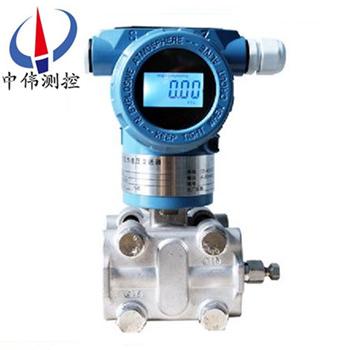Capacitive High Static Pressure Differential Pressure Transmitter
I. Product Overview:
ZW 151HP series capacitive high static pressure differential pressure transmitter is a new type of transmitter which imports advanced technology and equipment from abroad. It uses high static pressure diaphragm box. The so-called static pressure means that when the pressure on both sides of the pressure transmitter is the same, its output current should be 4 mA. But when the pressure on both sides of the ordinary differential pressure transmitter increases to more than 25 MPA at the same time, its output cannot be guaranteed at 4 mA. Therefore, it is mostly used for flow, liquid level measurement and high pressure occasions. It is mainly suitable for differential pressure transmitters of high-pressure devices in petrochemical and power plants. Because of its high pressure withstanding up to 32 MPa, and can withstand unidirectional overload pressure without being damaged, it can be reliably used for differential pressure measurement of high-pressure systems.
II. Working Principle:
ZW 151HP series capacitive high static pressure differential pressure transmitter is that two kinds of pressure of measured medium enter into high and low pressure chambers, and act on the isolation diaphragm of the two sides of the delta element (i.e. the sensitive element), which is transmitted to both sides of the measuring diaphragm through the isolator and the filling liquid in the element. A capacitor is formed by measuring the diaphragm and the electrodes on both sides of the insulating sheet. When the pressure on both sides is inconsistent, the displacement of the diaphragm is proportional to the pressure difference, so the capacitance on both sides is different, and the signal is converted into a signal proportional to the pressure through oscillation and demodulation.
3. Application occasions:
ZW1151HP series capacitive high hydrostatic differential pressure transmitter has 32Mpa resistance to working pressure and overload protection, which ensures that the transmitter can be used reliably in high hydrostatic system. Differential pressure transmitter is mainly used to measure the differential pressure, pressure, liquid level and density of liquid, gas or vapor, and then convert it into 4-20 mA.DC signal output.
Fourth, main characteristics:
1. High accuracy, good stability, two-wire system input (special four-wire system);
2. Solid components, plug-in printed circuit boards; small, light weight, strong anti-vibration;
3. Range, external zero point can be adjusted continuously, positive migration can reach 500%, negative migration can reach 600%.
4. Damping can be too adjustable and unidirectional overload protection has good characteristics.
5. No mechanical movable parts, less maintenance workload; a unified structure of the whole series, strong parts interchangeability;
6. The diaphragm material of contact medium can be selected; (316L, TAN, HAS-C, MONEL and other corrosion-resistant materials);
7. Explosion-proof structure, all-weather use; Intelligent HART Fieldbus protocol.
Technical parameters:
Performance Specifications: (Zero benchmark calibration range, reference conditions, silicone oil filling, 316L stainless steel isolation diaphragm.)
1. Reference accuracy:
(1) Digital and intelligent: +0.1% check full range.
(2) Simulated and linear: +0.2% calibration range.
2. Stability:
Number and Intelligence: 6 months, +0.1% URL.
(2) Simulated and linear: 6 months, +0.2% URL.
3. Environmental temperature effects:
Number and Intelligence: Zero Error: +0.2% URL/56 C, Total Error: +0.2% URL+0.18% Check Range) / 56 C.
(2) Simulation and linearity: Zero error: +0.5% URL/56 C, total error: +0.5% URL+0.5% check range) / 56 C.
4. Vibration effect: On any axis, the vibration effect at 200 Hz is +0.05% URL/g.
5. Power supply effect: less than +0.005% output range/volt.
6. Load effect: There is no load effect unless the supply voltage changes.
7. Electromagnetic Interference/Radio Frequency Interference (EMI/RFI): When the field intensity reaches 30V/M from 20 to 1000MHz, the output drift is less than (+0.1%).
8. Impact of installation location:



